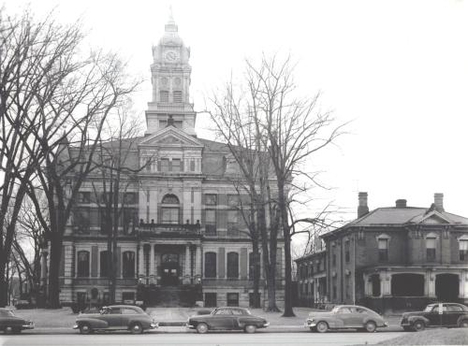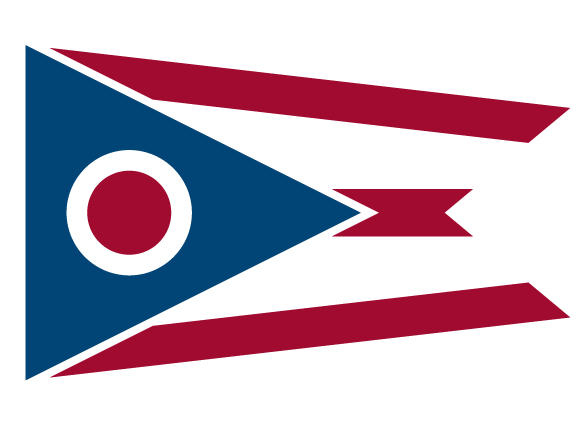UNION COUNTY CLERK OF COURTS
(1820-PRESENT)
In creating a state judicial system, the 1802 Ohio State Constitution provided for the appointment of a clerk of courts for each county. Originally, the clerk of courts was appointed by the judges of the court of common pleas for a seven year term. Under the 1851 Constitution, the office became elective for a three year term, which was extended to four years in 1936.
The clerk of courts maintains the records of the court of common pleas and various courts which have exercised appellate jurisdiction on the county level. The records of the common pleas court pertain to all civil cases in which the amount or matter in dispute exceeds the statutory jurisdiction of county or municipal courts, all criminal cases except those misdemeanors, which are vested by statute in an inferior court, and domestic relations cases. The common pleas court also holds appellate jurisdiction from decisions of the Board of County Commissioners or inferior courts. In addition, the common pleas court exercised jurisdiction in probate and testamentary matters from 1802 until the Probate Court was re-established in 1851.
COURT OF COMMON PLEAS – The origins of the court of common pleas date to a Northwest Territorial Act of 1788 which established the court, and empowered the governor of appoint judges with jurisdiction in civil matters. The Ohio Constitution of 1802 provided for the creation of a court of common pleas in each county to be appointed by the Ohio General Assembly. Judges served seven year terms or as long as they behaved well. The constitution also gave the court powers in probate, testamentary, and criminal matters. A legislative act the following year provided the court with original jurisdiction in all cases, both in law and equity.
In 1838, a superior court was established in Cincinnati with concurrent powers to that of the Hamilton County Court of Common Pleas. The 1851 Constitution decreed that judges would be elected by the people for seven year terms. The 1912 Constitutional Convention resulted in the term office being reduced to six years. The probate court was also begun as a separate court or division of the common pleas court. In Union County the probate court was begun as a separate court instead of a division of the common pleas court.
Statutory enactments, increasing case loads, and a changing society have led to the creation of a number of courts and departments of special jurisdiction under the court of common pleas umbrella. In 1904, the juvenile court was established with original jurisdiction in matters relating to minors. In Union County this court was attached jointly with the probate court under the jurisdiction of the probate court judge; creating a Probate and Juvenile Court instead of coupling it with the common pleas court. Nine years later, a domestic relations court was introduced to hear cases of divorce, alimony, illegitimacy, neglect and abuse of children, along with nonsupport and desertion cases. In 1925, each county was authorized to create a department of probation in the common pleas court to provide jurisdiction over probationers and parolees in the county, since that time the administration of the probation department has been transferred to the Ohio Department of Rehabilitation and Corrections, but a probation office is maintained and operated on the county level.

Union County Courthouse and Jail - c1940s
The records of the several courts which have exercised appellate jurisdiction on the county level include those of the Supreme Court (1826-1851), the District Court (1852-1884), the Circuit Court (1885-1912), and the current Court of Appeals (1913-present).
COURT OF APPEALS – Established in 1913, as the result of a 1912 constitutional amendment, the court of appeals has original jurisdiction in certain specified cases to review and affirm, modify or reserve judgments or actions of interior courts of record. Today, Ohio is divided into twelve appellate districts each of which is served by a court of appeals comprised of three judges. Additional judges may be added to a district by legislative action should court business warrant it. Judges serve elected terms of six years.
Prefiguring the modern court of appeals was the system of district courts adopted in the 1851 Ohio Constitution. In each judicial district, the district court system was composed of a supreme court justice and several common pleas judges from the district. The courts were assigned the same original jurisdiction as the supreme court, and such appellate jurisdiction as provided by law. The district courts were hampered in their operation due to the frequent absence of a supreme court justice necessitated by a burgeoning supreme court docket. In an attempt to alleviate this situation, in 1883 Ohio voters adopted an amendment to the constitution creating the circuit court. An act of 1884 divided the state into seven circuits and provided for the election of three judges in each circuit for six year terms. Acting as an independent intermediate court of appeal and error, the circuit courts were assigned similar duties as those of the predecessor district court. In 1913, the circuit courts were superseded by the court of appeals.
The clerk of courts is required by statute to file a complete record of all cases. In addition, the clerk must maintain an appearance docket, a trial docket, a journal, an execution docket, and indexes to these records. Throughout the history of this office, the clerk has acquired additional filing duties, such as recording notary commissions (1858), special police commissioners (1867-1935), certificates of judgment which would be considered as liens (1935), and automobile titles (1921).
In addition to receiving documents for record, the clerk of courts is responsible for other varied duties. For example, the clerk carries out all orders for the arrest of defendants, and files the indictment to the accused, and administers all oaths and affirmations required or authorized by law. Following conviction or rendition of judgment, the clerk prepares and itemized bill of the court costs. From 1856 to 1867, the clerk of courts maintained a list of births and deaths within the county and transmitted annually to the secretary of state an abstract of the list; from 1864 to 1890, the clerk served as the county supervisor of elections; and currently, the clerk serves as a member of the county records commission, data processing board and jury commission.
RECORDS OF THE UNION COUNTY CLERK OF COURTS
 An official State of Ohio government website.
Here's how you know
An official State of Ohio government website.
Here's how you know

